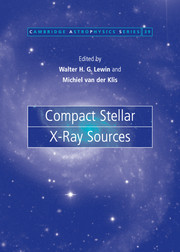Book contents
- Frontmatter
- Contents
- List of contributors
- Preface
- 1 Accreting neutron stars and black holes: a decade of discoveries
- 2 Rapid X-ray variability
- 3 New views of thermonuclear bursts
- 4 Black hole binaries
- 5 Optical, ultraviolet and infrared observations of X-ray binaries
- 6 Fast X-ray transients and X-ray flashes
- 7 Isolated neutron stars
- 8 Globular cluster X-ray sources
- 9 Jets from X-ray binaries
- 10 X-rays from cataclysmic variables
- 11 Super-soft sources
- 12 Compact steller X-ray sources in normal galaxies
- 13 Accretion in compact binaries
- 14 Soft gamma repeaters and anomalous X-ray pulsars: magnetar candidates
- 15 Cosmic gamma-ray bursts, their afterglows, and their host galaxies
- 16 Formation and evolution of compact stellar X-ray sources
- Author index
- Subject index
5 - Optical, ultraviolet and infrared observations of X-ray binaries
Published online by Cambridge University Press: 01 September 2009
- Frontmatter
- Contents
- List of contributors
- Preface
- 1 Accreting neutron stars and black holes: a decade of discoveries
- 2 Rapid X-ray variability
- 3 New views of thermonuclear bursts
- 4 Black hole binaries
- 5 Optical, ultraviolet and infrared observations of X-ray binaries
- 6 Fast X-ray transients and X-ray flashes
- 7 Isolated neutron stars
- 8 Globular cluster X-ray sources
- 9 Jets from X-ray binaries
- 10 X-rays from cataclysmic variables
- 11 Super-soft sources
- 12 Compact steller X-ray sources in normal galaxies
- 13 Accretion in compact binaries
- 14 Soft gamma repeaters and anomalous X-ray pulsars: magnetar candidates
- 15 Cosmic gamma-ray bursts, their afterglows, and their host galaxies
- 16 Formation and evolution of compact stellar X-ray sources
- Author index
- Subject index
Summary
Introduction
In the 35 years since the first X-ray binary was optically identified (Sco X-1) the basic division of X-ray binaries into the high-mass (HMXBs) and low-mass (LMXBs) systems has become firmly established. The nomenclature refers to the nature of the mass donor, with HMXBs normally taken to be ≥10 M⊙, and LMXBs ≤1 M⊙. However, the past decade has seen the identification and measurement of a significant number of X-ray binaries whose masses are intermediate between these limits. Nevertheless, the nature of the mass-transfer process (stellar wind dominated in HMXBs, Roche lobe overflow in LMXBs) produces quite different properties in the two groups and so this chapter will be divided into two main sections on HMXBs and LMXBs. A more complete introduction can be found in Chapter 1.
While the nature of the compact object and its properties are largely determined from X-ray studies, longer-wavelength observations allow detailed studies of the properties of the mass donor. This is most straightforward for the intrinsically luminous early-type companions of HMXBs, which provide the potential for a full solution of the binary parameters for those systems containing X-ray pulsars. This is particularly important for HMXB evolution in that it allows a comparison of the derived masses with those obtained for neutron stars in the much older binary radio pulsar systems (Thorsett & Chakrabarty 1999).
However, when HMXBs are suspected of harboring black holes (e.g., Cyg X-1), the mass measurement process runs into difficulties.
- Type
- Chapter
- Information
- Compact Stellar X-ray Sources , pp. 215 - 266Publisher: Cambridge University PressPrint publication year: 2006
- 90
- Cited by

